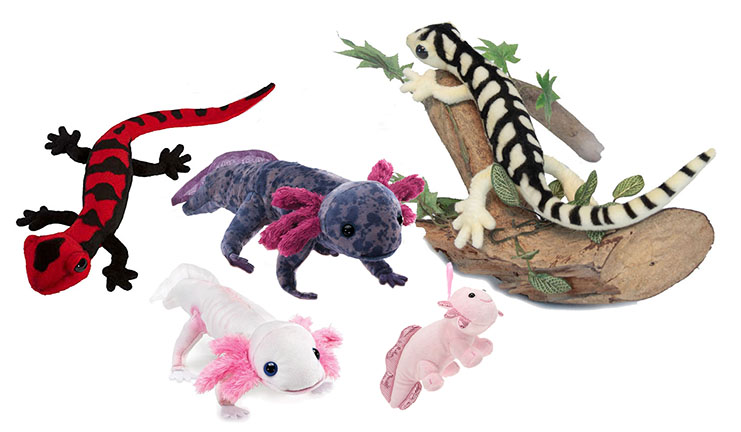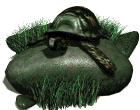Find rubber and plush toy Salamanders at Animals N More.
These salamanders are from Folkmanis, Hansa and Unipak. The plush salamanders come from Hansa and show a fire salamander and a bulldog salamander. The Folkmanis Axolotl is a type of salamander and is extremely rare in the wild. They are hand puppets. The little pink Axolotl key clip is from Unipak. These salamanders can be found in our sponsor's online gift shop.
Salamanders are amphibians. The word salamander comes from the Greek word Salamandra meaning fire lizard. They have a lizard-like appearance with slender bodies, moist skin, blunt snouts and the presence of tails in both the larvae and adults.
They are found in a variety of environments from ponds, lakes, rivers, creeks and brooks. There are more kinds of salamanders in North America than in all other parts of the world. There are none in Australia.
Salamanders do not like bright light or dry air. They can usually be found in moist places under rocks or logs. They generally travel at night. They can regrow lost limbs and tails.
The ways salamanders breathe vary among the various types. While all the larvae use gills for breathing, some adults have lungs, some have gills and some have neither, breathing only through their skin and the lining of the mouth and throat.
Among salamanders the eggs are commonly (but not always) fertilized as they are being laid. In some cases is has been observed that there is a great courtship ritual that takes place, such as the Tiger Salamanders and Red Salamanders. The male places a sperm packet (spermatophore) on the ground or in a pool. The female then inserts it into her cloaca to fertilize her eggs. The eggs are then placed on sticks or under rocks.
The size of salamanders varies greatly. The largest is the Giant salamander which can grow to more than five feet. The smallest is the Pygmy Salamander which is barely an inch in length.
What do Salamanders eat? Their diet consists of insects, millipedes, worms and slugs. They are completely carnivorous. They prefer their food to be alive. They are attracted by the movement. Terrestrial salamanders use their sticky tongues to catch their food and aquatic salamanders just grab their food with their open mouths. Salamanders will eat just about anything they can fit in their mouths.
The lifespan of salamanders can range from 3 to 25 years.
Photo of frosted flatwoods salamander courtesy USGS/USGS





